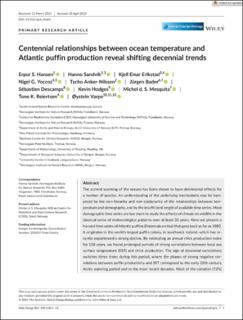| dc.contributor.author | Hansen, Erpur S. | |
| dc.contributor.author | Sandvik, Hanno | |
| dc.contributor.author | Erikstad, Kjell E. | |
| dc.contributor.author | Yoccoz, Nigel | |
| dc.contributor.author | Anker-Nilssen, Tycho | |
| dc.contributor.author | Bader, Jürgen | |
| dc.contributor.author | Descamps, Sebastien | |
| dc.contributor.author | Hodges, Kevin | |
| dc.contributor.author | Mesquita, Michel d. S. | |
| dc.contributor.author | Reiertsen, Tone Kristin | |
| dc.contributor.author | Varpe, Øystein | |
| dc.date.accessioned | 2021-10-22T07:21:52Z | |
| dc.date.available | 2021-10-22T07:21:52Z | |
| dc.date.created | 2021-05-19T08:28:38Z | |
| dc.date.issued | 2021 | |
| dc.identifier.issn | 1354-1013 | |
| dc.identifier.uri | https://hdl.handle.net/11250/2824869 | |
| dc.description.abstract | The current warming of the oceans has been shown to have detrimental effects for a number of species. An understanding of the underlying mechanisms may be hampered by the non-linearity and non-stationarity of the relationships between temperature and demography, and by the insufficient length of available time series. Most demographic time series are too short to study the effects of climate on wildlife in the classical sense of meteorological patterns over at least 30 years. Here we present a harvest time series of Atlantic puffins (Fratercula arctica) that goes back as far as 1880. It originates in the world’s largest puffin colony, in southwest Iceland, which has recently experienced a strong decline. By estimating an annual chick production index for 128 years, we found prolonged periods of strong correlations between local sea surface temperature (SST) and chick production. The sign of decennial correlations switches three times during this period, where the phases of strong negative correlations between puffin productivity and SST correspond to the early 20th century Arctic warming period and to the most recent decades. Most of the variation (72%) in chick production is explained by a model in which productivity peaks at an SST of 7.1 °C, clearly rejecting the assumption of a linear relationship. There is also evidence supporting non-stationarity: the SST at which puffins production peaked has increased by 0.24 °C during the 20th century, although the increase in average SST during the same period has been more than three times faster. The best supported models indicate that the population’s decline is at least partially caused by the increasing SST around Iceland. | en_US |
| dc.language.iso | eng | en_US |
| dc.publisher | Wiley | en_US |
| dc.rights | Attribution-NonCommercial-NoDerivatives 4.0 Internasjonal | * |
| dc.rights.uri | http://creativecommons.org/licenses/by-nc-nd/4.0/deed.no | * |
| dc.title | Centennial relationships between ocean temperature and Atlantic puffin production reveal shifting decennial trends | en_US |
| dc.type | Peer reviewed | en_US |
| dc.type | Journal article | en_US |
| dc.description.version | publishedVersion | en_US |
| dc.subject.nsi | VDP::Zoologiske og botaniske fag: 480 | en_US |
| dc.subject.nsi | VDP::Zoology and botany: 480 | en_US |
| dc.source.journal | Global Change Biology | en_US |
| dc.identifier.doi | 10.1111/gcb.15665 | |
| dc.identifier.cristin | 1910637 | |
| dc.relation.project | Framsenteret: Flaggskip kystøkologi | en_US |
| dc.relation.project | Norges forskningsråd: 223257 | en_US |
| cristin.ispublished | false | |
| cristin.fulltext | original | |
| cristin.qualitycode | 2 | |

